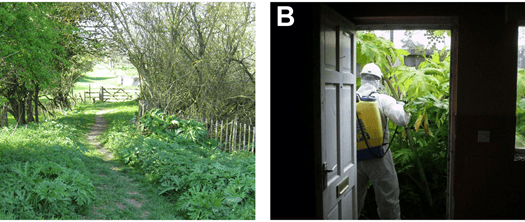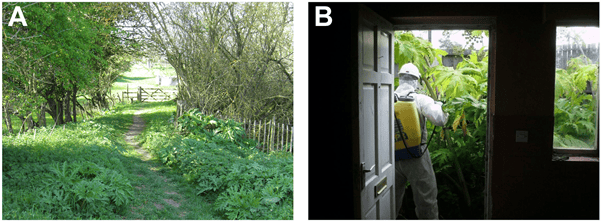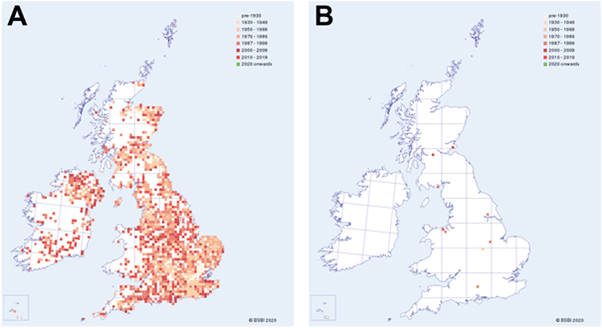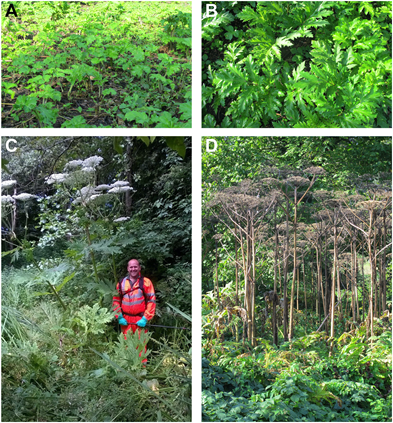Giant Hogweed – Emerging Liability.

Giant hogweed is notable amongst invasive plants in the UK in that it has direct harmful human health implications, as well as negative effects on the native ecology and environment of the UK. Following recent surveyor negligence claims, this article reviews hogweed in the context of its ecology and biology in the non-native range and how the toxicity of this species may impact upon surveyor practice in the future.
What is giant hogweed and where is it found?
Giant hogweed (Heracleum mantegazzianum) originates from the Caucasus Mountains of Southwest Asia and was introduced as a horticultural species to Britain in 1893. n the UK, Giant hogweed escaped from garden plantings and spread rapidly along watercourses, colonising damp ground and wasteland. Subsequently, the invasive plant has invaded secondary habitats, including roadsides, railway embankments and amenity areas adjoining commercial and residential properties (figure 1).
Giant hogweed negatively impacts on UK native ecology by shading out native plants; additionally, safe access to riverbanks and amenity areas is hampered and extensive aboveground growth increases riverbank erosion risk.

Figure 1A) Giant hogweed growing along a public right of way.
Figure 1B) Giant hogweed growing directly against a residential property, making safe access to the building impossible (courtesy of Brian Taylor).
© The Knotweed Company 2020
Similarly to many of the terrestrial invasive plants found in the UK, ‘Giant hogweed’ is often used to refer to a group of closely related invasive species, in this case consisting of Persian hogweed (H. persicum) originating from Turkey, Iran, Iraq, and Sosnowsky’s hogweed (H. sosnowskyi) introduced from the Caucasus, Transcaucasia and Northeast Turkey. While Giant and Persian hogweeds have been recorded in the UK (figure 2), Sosnowsky’s hogweed has not (as yet). However, identification of these species can be problematic, leading to misidentification, and given that all three species are widespread in Continental Europe, it is likely that records of Sosnowsky’s hogweed will be reported in the future.

Figure 2A) Giant hogweed and figure 2B) Persian hogweed distribution in the UK and Ireland (courtesy of BSBI 2020). Giant hogweed is widespread throughout the UK and Ireland, while Persian hogweed is restricted to a handful of records in England, Wales and Scotland.
© BSBI 2020
Biology
Giant hogweed is among the tallest perennial herbs in Europe, reaching up to 5.5m tall in full growth (figure 3). Germination of seeds begins in January/February, while growth of established plants begins from January through to March. Within the first year of growth, giant hogweed leaves grow large in size and are dark green in colour with pronounced lobes, deep incisions and spiked ends. Giant hogweed is monocarpic i.e. it flowers once and dies. In the first year of growth, plants accumulate resources in a deep taproot and once sufficient reserves are available, flowering occurs in subsequent years. Typically, flowering occurs from June to August in the second year of growth, though it may take longer depending on local growing conditions (4 years from germination to flowering has been reported). Flowering stems are hollow, hairy, and dark green in colour, with red/purple blotches; these support the very large flower (‘umbel’ in botanical terms) head, which is frequently more than 50cm wide. Each flower head consists of numerous small white flowers which are attractive to native pollinating insects. Following insect pollination, seed is set and these are subsequently shed directly around the parent plant (up to 5m away) and indirectly spread by anthropogenic (e.g. roadside slipstreams) and natural processes (e.g. flooding) over much greater distances. Rapid spread of giant hogweed in the UK landscape is well understood with reference to seed production: each plant produces 20,000 – 100,000 seeds and these remain viable in the soil for between 7 and 15 years.

Figure 3A & B) Seedlings in the first year of growth, highlighting dark green leaf colour, pronounced lobes, deep incisions and spiked ends; also note dense growth which excludes native plant species from early in the growing season. Figure C) Mature giant hogweed growth including leaves, flower stem and large flower (umbel); for scale, Gethin Bowes, Invasive Plant Species Officer, Caerphilly County Borough Council, is 1.85m tall. Figure D) Shows dead stems and flowers in autumn once the biennial life cycle is completed.
A, B & D © Advanced Invasives 2020
C © Gethin Bowes, Caerphilly County Borough Council
In contrast with Japanese knotweed, mature and immature Giant hogweed plants can be killed outright using a number of different herbicides and, with a lot of persistence, the seed bank can also be brought under control. Estimated costs associated with the management of Giant hogweed are in the region of £2.4 million per annum in the UK, though this is likely to be an underestimate of the actual costs incurred. Physical control methods, such as strimming, should be avoided as fragmenting the plant produces a large quantity of toxic sap, and the long-term efficacy of these operations is limited as funding is frequently exhausted before the successful conclusion of management programmes. However, once all mature individuals are dead and the seedbank is entirely depleted, Giant hogweed can be declared locally ‘eradicated’, though there is the ongoing risk of reinvasion from neighbouring land and/or populations of the plant upstream of the treated area.
Perception and Reality
While Japanese knotweed (Reynoutria japonica) and increasingly, Butterfly Bush (Buddleja davidii) capture the attention of the public because of their impacts (real and perceived) on the built environment[1], Giant hogweed has captured headlines for quite different reasons. Giant hogweed is a member of the carrot family (Apiaceae), which includes the food plants carrot, parsnip, and coriander. There are more than 50 UK native species within the Apiaceae family, including Common hogweed (Heracleum sphondylium), Wild carrot (Daucus carota) and Cow parsley (Anthriscus sylvestris). Superficial similarity of Giant hogweed with other native members of the carrot family is reflected in the common names ascribed to the plant, which include giant cow parsley, giant cow parsnip and hogsbane.
Many native Apiaceae are toxic, the best known being Hemlock (Conium maculatum). Hemlock contains a number of toxic alkaloids including coniine and was used by the classical philosopher Socrates to commit suicide after being sentenced to death for his belief in democratic principles. Many Apiaceae contain further harmful phytotoxins: furanocoumarins and their derivatives. In the plant family Heracleum and Giant hogweed in particular, furanocoumarins contained in the plant leaves and/or roots, stems, flowers, and seeds are principally accumulated to deter herbivorous insect feeding. In cases where these compounds come into direct contact with humans and livestock, following cutting or grazing, they cause phytophotodermatitis, resulting in blistering and scaring that may be extensive if, for example, the plant has been cut using a strimmer. The human health impacts of chemical burns, particularly in young children, have triggered quite understandable and extensive media coverage over the past decades, and particularly over the last 10 years in the UK[2],[3], and North America[4].
With negative environmental impacts and direct human health impacts of Giant hogweed established, beginning in the 1980s UK Government introduced legislation to stem the spread of the plant throughout the UK. While the legislation surrounding giant hogweed is less extensive than that associated with Japanese knotweed, relative to other European countries and North America it remains comprehensive.
Legislation Summary
Giant hogweed is subject to legislation, some of which is relevant to discussion of the effects in the built environment and:
• Giant hogweed is listed in Schedule 9 of The Wildlife and Countryside Act 1981 – this legislation makes it an offence to plant giant hogweed or cause it to grow in the wild.
• However, it is not illegal for giant hogweed to be on private land and there is no legal obligation to remove or control hogweed on private land. There is also no requirement to report that giant hogweed is present on the land. That said, allowing plant material or soil contaminated with hogweed seeds from any waste transfer to spread into the wild could lead to a fine of up to £5,000 or a prison term of up to two years.
• Currently, there is no precedent set for private actions by landowners of adjacent properties seeking damages should Giant hogweed be allowed to spread onto their property. However, there is a significant risk of civil liability centred on harm caused by exposure to giant hogweed sap, for instance where a property is infested with the plant and treatment attempted, resulting in chemical burns to the property buyer.
• Giant hogweed is classed as ‘controlled waste’ so must be disposed of safely at a licensed landfill site in accordance with the Environmental Protection Act (Duty of Care) Regulations 1991. This does not just apply to the plant material above ground. Soil containing roots and seeds may be regarded as contaminated and, if taken off a site, must be disposed of at a suitably licensed landfill site. Section 33 of the Environmental Protection Act states that it is an offence to deposit, treat, keep, or dispose of controlled waste without a licence.
Giant hogweed is therefore a future ‘risk’ to those working in the property sector.
Where does this leave property surveyors?
While the risk of property damage caused by the growth of Giant hogweed is limited, there is a significant risk of civil litigation in circumstances where the plant has not been reported clearly, and subsequently controlled effectively and safely (e.g. where it has inadvertently been cut using machinery, exposing the operator and/or property to toxic sap). Recent media headlines highlighting chemical burns following exposure to toxic sap and reporting on the ongoing spread of Giant hogweed in the UK landscape emphasise the importance of effective plant identification by surveyors during property surveys. Training and ongoing vigilance will help to minimise health and legal risks associated with this invasive plant to both property surveyors and buyers in the future. It also has implications for those responsible for management of land and common areas, such as gardens.
Next Steps
Advanced Invasives and Sava are developing a series of competency-based qualifications designed to assist surveyors with the identification, survey and appraisal of giant hogweed and other invasive plants in the property context.
[1] Fennell M, Wade M & Bacon KL (2018) Japanese knotweed (Fallopia japonica): an analysis of capacity to cause structural damage (compared to other plants) and typical rhizome extension. PeerJ 6:e5246; DOI 10.7717/peerj.5246.
[2] Richardson H (2020). Mail Online. Available from: http://dailym.ai/3gcHQYh [Accessed 24/05/20].
[3] Rowney JA (2019). Mirror. Available from: https://bit.ly/3ebBdUf [Accessed 24/05/20].
[4] CBC News (2011). CBC News. Available from: https://cbsn.ws/2LSwR8b [Accessed 24/05/20].